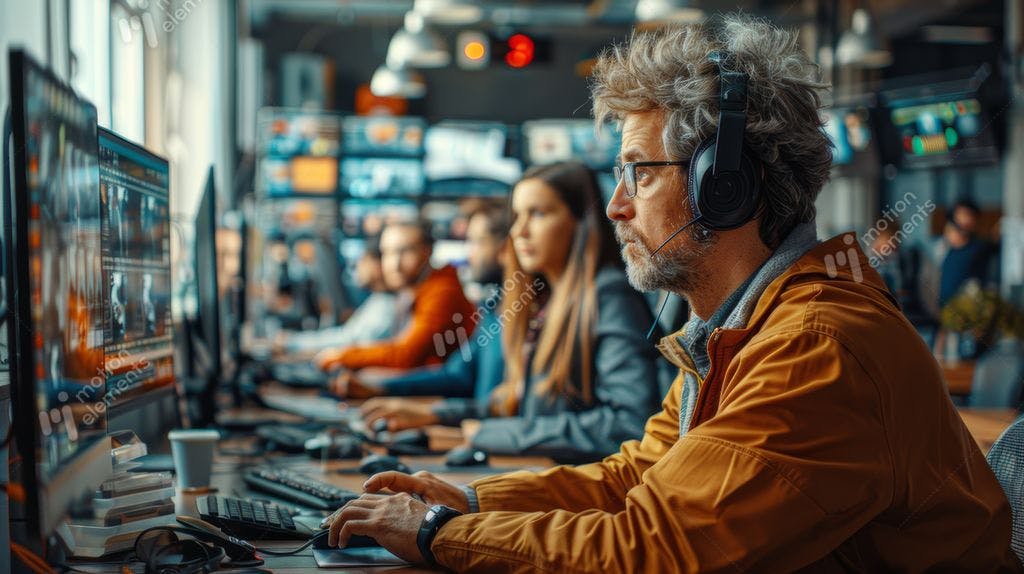Video editing is one of the important skills that every filmmaker and content creator would want to have in the digital era. As much as the ease of digital technology makes it an indispensable component of filmmaking, most filmmakers are still in love with the appeal that conventional film carries. The "film look" effect with digital video requires a combination of technical know-how and creative perception. It's about walking through various techniques and tools that will help you bring this timeless film aesthetic into your digital projects.
MotionElements Film Look Video content site
1. Understanding the "Film Look"
What is Film Look?
The "film look" represents a combination of certain characteristics peculiar to itself and distinct from digital video. This includes special color tones, grainy textures, and that peculiar manner in which film handles light and shadow. Knowing these elements first provides the basis on which to mimic them through video editing.
Why the Film Look Matters in Digital Video Editing:
Digital video is sharp and to the point, whereas the film look provides a depth that is more emotive and real. It is a matter of aesthetic choice and henceforth storytelling; this will make the process of video editing not only about cutting footage but also an act of creating a visual experience that touches base with the audience.
Examples of the Film Look in Modern Cinema
Discuss some of the recent movies that have managed to achieve this look despite being filmed digitally. These examples shall inspire the reader and provide real reference points when working on their own video editing projects.
2. Techniques for Color Grading
Color Grading in Video Editing:
An Introduction Color grading is among the important steps of achieving the film look; it involves adjusting the colors of your footage to match those tonal qualities of traditional film stocks. In video editing, this may greatly change the mood and atmosphere of your project.
Choosing the Right LUTs:
Look-Up Tables A LUT is a pre-set color profile applied to your footage to achieve desired looks. This section shows you how to choose LUTs reminiscent of classic film stocks and apply them effectively in your video editing software.
Color Balance for a Cinematic Feel:
Discuss color contrast balance, saturation, and exposure. If you want, you can also bring up the points of not over-processing and how to keep it natural. This helps retain the authenticity of the film look during video editing.
3. Film Grain and Texture
Film Grain in Video Editing
Adding film grain to your video creates a textured feeling to make it look like it was shot on celluloid. This section includes how you can add film grain using several video editing applications and plugins for each.
Adding Extra Texture with Overlays
Besides grain, other overlays that can add texture to your footage include light leaks, scratches, and dust. Step-by-step details on how you can add these will ensure your video editing process yields a very richly textured final product.
Adding Grain without Sacrificing Quality
One of the greatest challenges that video editors have to put up with is knowing just how to add grain without sacrificing quality within their footage. This section gives you some technical tips on how to do this so that your video maintains its sharpness while at the same time gaining benefits from the added texture.
4. Changing Aspect Ratios and Frame Rates
Aspect Ratios That Evoke the Film Look
The aspect ratio greatly helps to produce that film look and feel. For most classic films, shooting has been done using a wide screen format that you can replicate in your video editing software application. This section looks at some of the aspect ratios that were used in classic cinema and how to create them in your projects.
Frame Rate Considerations in Video Editing
Film is usually shot at 24 frames per second, which gives it a peculiar motion blur absent in digital video. By editing video and changing the frame rate, you will be able to create this effect practically, allowing your digital footage to feel more like film.
Letterboxing and Cropping:
Cinematic Techniques The letterboxing and cropping are just two of the editing techniques in video that will grant you the ability to change the aspect ratio of your footage. In this section, you will go into the step-by-step process of applying these techniques to give your video a cinematic presentation.
5. Final Tips for Film Look in Digital Video
Consistency Is Key in Video Editing:
Consistency in what you're doing might mean color grading, adding grain, or choosing an aspect ratio throughout your project to get that film look in video editing.
Investing in good video editing software and plugins is using the right tool.
This section will recommend a number of the best tools to achieve the film look-some software like DaVinci Resolve, Adobe Premiere Pro, and Final Cut Pro, among others-and also some plugins that enhance your video editing workflow.
Experimentation and Creativity
Although the above methods have been tried and tested, do not be afraid to experiment. That is the beauty of video editing: flexibility. Fiddle with settings and effects until you get a combination that will work best for your project.
Conclusion
Achieving a film look in digital video is a very rewarding challenge that makes qualitative increases to your final work. By grasping the basic elements of traditional film and taking thought to video editing, you'll be able to create projects that just stand out and resonate with emotional depth and richness similar to classic cinema. So, get up and begin experimenting with these techniques today, and watch your videos transform into cinematic masterpieces.
